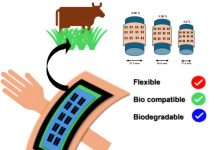
Researchers at Linköping University in Sweden have made a significant breakthrough in display technology that could change the way we interact with our electronic devices.
They have developed a type of screen that doesn’t just show images but can also sense touch, light changes, fingerprints, and even the user’s heartbeat.
This discovery was detailed in a recent publication in Nature Electronics.
The key ingredient in these advanced screens is a crystalline material known as perovskite. Perovskites are known for their exceptional ability to absorb and emit light.
This characteristic has opened the door to incorporating multiple functions into the screen itself, eliminating the need for additional sensors that current screens require.
Feng Gao, a professor at Linköping University and an expert in optoelectronics, explained the significance of their work: “We have proven our design works.
There’s a big potential for these multi-functional displays in everyday devices like phones, tablets, and computers. The next step is refining the technology for commercial use.”
Modern screens like those found in smartphones and tablets are typically only capable of displaying images.
If these devices need to detect touch or identify a fingerprint, separate sensors must be added either on top or around the screen.
The new technology developed by the Swedish team integrates these capabilities directly into the screen, streamlining the design and potentially reducing costs.
One of the more exciting features of these screens is their ability to double as solar cells. For instance, when a smartwatch screen is not in use, it could automatically switch to a mode that allows it to absorb light and recharge the battery.
Chunxiong Bao, who co-authored the study and is an associate professor at Nanjing University, highlighted this advantage: “Imagine your smartwatch charging itself while you’re not using it. This could significantly extend the battery life between charges.”
These innovative screens are made up of perovskite LEDs that can emit red, green, and blue light, which are essential for creating the full spectrum of colors we see on digital displays. This development paves the way for screens capable of vibrant and varied color displays.
However, there are still hurdles to overcome before these screens can be widely adopted.
One major challenge is the lifespan of perovskite LEDs; currently, they only function for a few hours before the material begins to degrade. Zhongcheng Yuan, a researcher from the University of Oxford and another lead author of the study, remains optimistic.
He believes that these issues are likely to be resolved within the next decade, making these advanced screens a common feature in future electronics.
As technology advances, the possibility of having a device that not only displays content but also interacts intelligently with its environment is becoming more realistic.
These next-generation screens could one day make our gadgets more intuitive and energy-efficient than ever before.



